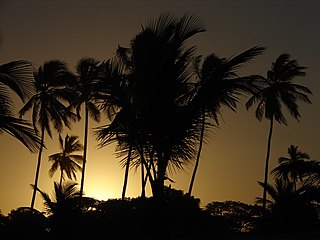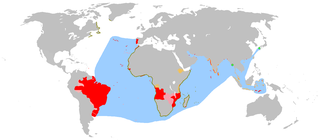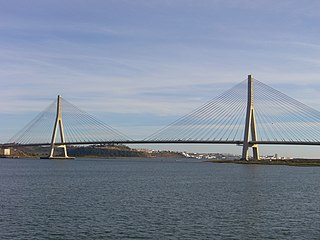
The Azores, officially the Autonomous Region of the Azores, is one of the two autonomous regions of Portugal. It is an archipelago composed of nine volcanic islands in the North Atlantic Ocean about 1,360 km (850 mi) west of continental Portugal, about 1,643 km (1,021 mi) west of Lisbon, in continental Portugal, about 1,507 km (936 mi) northwest of Morocco, and about 1,925 km (1,196 mi) southeast of Newfoundland, Canada.

Bartolomeu Dias, a nobleman of the Portuguese royal household, was a Portuguese explorer. He sailed around the southernmost tip of Africa in 1488, the first to do so, setting up the route from Europe to Asia later on. Dias is the first European during the Age of Discovery to anchor at what is present-day South Africa.

The Bandeirantes were 17th-century Portuguese settlers in Brazil and fortune hunters. This group mostly hailed from the São Paulo region, which was known as the Captaincy of São Vicente until 1709 and then as the Captaincy of São Paulo. They led expeditions called bandeiras which penetrated the interior of Brazil far west of the Tordesillas Line of 1494, which officially divided the Castilian, later Spanish, (west) domain from the Portuguese (east) domain in South America.
São Jorge, Portuguese for Saint George, may refer to the following places:

São Jorge is an island situated in the central group of the Azores archipelago and part of the autonomous region of Portugal. Separated from its nearest neighbors by the 15 kilometres (9.3 mi) Pico-São Jorge Channel, the central group is often referred colloquially as part of the Triangulo ("Triangle") group or just "The Triangle". São Jorge is a relatively long thin island with tall cliffs, whose 9500 inhabitants are concentrated on various geological debris fields (fajãs) along the north and south coasts; from east to west, the island is 53 kilometres (33 mi) long and, north to south, 8 kilometres (5.0 mi) wide: its area is 237.59 square kilometres (91.73 sq mi).

Calheta is a municipality on the island of São Jorge, in the Portuguese autonomous region of Azores. The municipality includes the eastern portion of the island of São Jorge and borders the municipality of Velas. The population in 2011 was 3,773, in an area of 126.26 km².

Serreta is a civil parish in the municipality of Angra do Heroísmo on the island of Terceira in the Portuguese archipelago of the Azores. Its elevation is approximately 471 metres (1,545 ft). The population in 2011 was 335, in an area of 14.36 km2. It is the smallest parish in the municipality by population.

Ilhéus is a major city located in the southern coastal region of Bahia, Brazil, 211 km south of Salvador, the state's capital. The city was founded in 1534 as Vila de São Jorge dos Ilhéus and is known as one of the most important tourism centers of the northeast of Brazil.

Elmina Castle was erected by the Portuguese in 1482 as São Jorge da Mina Castle, also known simply as Mina in present-day Elmina, Ghana. It was the first trading post built on the Gulf of Guinea, and the oldest European building in existence south of the Sahara. First established as a trade settlement, the castle later became one of the most important stops on the route of the Atlantic slave trade. The Dutch seized the fort from the Portuguese in 1637, and took over all the Portuguese Gold Coast in 1642. The slave trade continued under the Dutch until 1814. In 1872, the Dutch Gold Coast, including the fort, became a possession of the British Empire.

São Jorge is a civil parish in the municipality of Santana, in the island of Madeira. The population in 2011 was 1,473, in an area of 19.34 km².

The Portuguese Gold Coast was a Portuguese colony on the West African Gold Coast on the Gulf of Guinea.

São Jorge Airport is the only airport of the island of São Jorge, situated in the civil parish of Santo Amaro, municipality of Velas in the Azores.
Jorge Maria O'Neill, 5th Viscount of Santa Mónica was the head of a branch of one of the principal Irish Royal Families, the Clanaboy O'Neill dynasty, which has resided in Portugal since the 18th century.
Hugo Ricciardi O'Neill, 6th Viscount of Santa Mónica is the current head of a branch of the O'Neill dynasty of Clanaboy, whose family has been in Portugal since the 18th century.

São Jorge is a settlement in the central part of the island of Santiago, Cape Verde. It is part of the São Lourenço dos Órgãos municipality. In 2010 its population was 6. It is situated 2.5 km southwest of João Teves and 4 km southeast of Picos. Its elevation is 319 meters.

Domingos Jorge Velho (1641–1705) was one of the most fierce and effective Portuguese bandeirantes. He was born in Santana de Parnaíba, captaincy of São Paulo, to Francisco Jorge Velho and Francisca Gonçalves de Camargo. He was responsible for the repression of several indigenous nations in Bahia and especially Piauí, which he is reputed to have been the first colonist to explore. His greater fame, however, is due to his conquest of the Quilombo dos Palmares, in the hinterland of Alagoas, on behalf of João da Cunha Souto Maior, governor of Pernambuco. Velho accepted the assignment and, in 1694, with an army of Indians and mamelucos, European Native American offspring, overran the fortified city of Macacos, on the Serra da Barriga mountain.

São Jorge Cheese is a semi-hard to hard cheese, produced on the island of São Jorge, in the Portuguese archipelago of the Azores, certified as a Região Demarcada do Queijo de São Jorge and regulated as a registered Denominação de Origem Protegida.

Portuguese colonial architecture refers to the various styles of architecture that the Portuguese built across the Portuguese Empire. Portuguese colonial Architecture can be found in the plethora of former colonies throughout South America, North Africa, Sub-Saharan Africa, India, Oceania, and East Asia. Many former colonies, especially Brazil, Macau, and India, promote their Portuguese colonial architecture as major tourist attractions.

Caldas de São Jorge e Pigeiros is a civil parish in the municipality of Santa Maria da Feira, Portugal. It was formed in 2013 by the merger of the former parishes Caldas de São Jorge and Pigeiros. The population in 2011 was 3,897, in an area of 10.64 km².

The Ginásio Poliesportivo Wlamir Marques, previously known as the Ginásio Poliesportivo Parque São Jorge, is a multipurpose indoor arena that is located in the Tatuapé district of São Paulo, Brazil. It is a part of the Parque São Jorge multi-sports complex. The arena is primarily used to host basketball games, for which it has a seating capacity of 7,000 people.


















